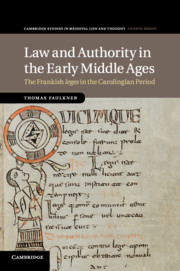Book contents
- Frontmatter
- Contents
- List of illustrations
- List of tables
- Abbreviations
- INTRODUCTION
- 1 THE MINOR leges PART I. PROBLEMS, BACKGROUND, Lex Ribuaria, Ewa ad Amorem
- 2 THE MINOR leges 2. SAXONY AND THE Lex Saxonum
- 3 THE ADDITIONAL CAPITULARIES
- 4 THE READING OF NORMATIVE TEXTS: BENEDICTUS LEVITA AND REGINO
- 5 THE MANUSCRIPTS OF THE leges-SCRIPTORIUM
- CONCLUSION
- Editions
- Bibliography
- General index
- Index of legal texts
- Index of manuscripts
5 - THE MANUSCRIPTS OF THE leges-SCRIPTORIUM
Published online by Cambridge University Press: 05 February 2016
- Frontmatter
- Contents
- List of illustrations
- List of tables
- Abbreviations
- INTRODUCTION
- 1 THE MINOR leges PART I. PROBLEMS, BACKGROUND, Lex Ribuaria, Ewa ad Amorem
- 2 THE MINOR leges 2. SAXONY AND THE Lex Saxonum
- 3 THE ADDITIONAL CAPITULARIES
- 4 THE READING OF NORMATIVE TEXTS: BENEDICTUS LEVITA AND REGINO
- 5 THE MANUSCRIPTS OF THE leges-SCRIPTORIUM
- CONCLUSION
- Editions
- Bibliography
- General index
- Index of legal texts
- Index of manuscripts
Summary
PRELIMINARIES
The importance of the material
The leges-scriptorium group, identified by Bischoff and later studied in detail by McKitterick, is the largest group of early medieval manuscripts with broadly legal concerns the members of which can be associated with each other on palaeographical grounds. Bischoff and McKitterick attributed them to the 820s–30s, linked them with a style current at Tours, and with the imperial court of Louis the Pious.
At the very least, this group sheds some light on the circulation of legal texts soon after their composition, since those containing Louis's capitularies have contents roughly contemporary with their construction. But McKitterick went further, and argued that they may indeed show something of how legal texts, capitularies as well as up-to-date texts of the leges, were disseminated by the imperial court. Otherwise only a very few fragments of what could be early rotula survive to help us establish what capitularies looked like in their original manuscript context, their first written fixing after some kind of promulgation. Establishing the precise status of this scriptorium, then, is a task of the very highest importance in the study of Carolingian legal culture, possibly allowing us a rare direct insight into the tangible, direct contribution of the Carolingian court to the textual history of capitularies and leges.
A further study of these manuscripts is particularly needed because, as McKitterick herself noted, they display notable eccentricities, if we do imagine that they are products of a scriptorium systematically disseminating correct, ‘official’ texts for use in courts. Chief among these is the discrepancy between the redactions of the Lex Salica the scriptorium produced. While some contain the ‘Karolina’ (K) text, considered a product of Charlemagne's court, others copied the earlier Carolingian E text.
I start with a survey of the manuscripts and their content, and draw attention to further discrepancies in the texts they reproduced. I then discuss other notable divergences in the form of the manuscripts, their dimensions, use of abbreviations, and use of Tironan notes, which have not been noted explicitly so far.
- Type
- Chapter
- Information
- Law and Authority in the Early Middle AgesThe Frankish leges in the Carolingian Period, pp. 193 - 247Publisher: Cambridge University PressPrint publication year: 2016



